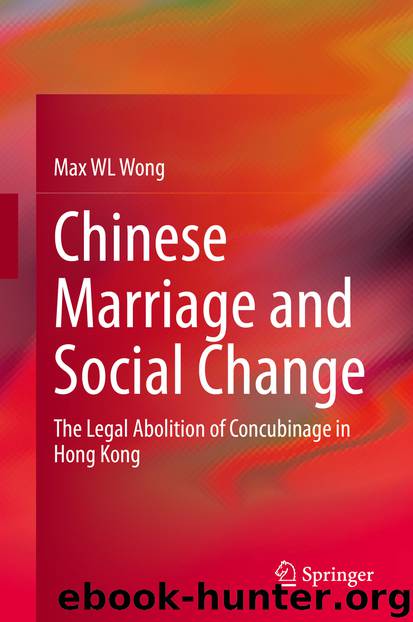Chinese Marriage and Social Change by Max WL Wong

Author:Max WL Wong
Language: eng
Format: epub
ISBN: 9789811516443
Publisher: Springer Singapore
4.2.7 Abolition of Concubinage
The Committee had some considerations in proposing changes to the Hong Kong laws relating to Chinese law and custom. These were later published in the final report as submitted by the Strickland Committee. First, because of the flow of migrants to and from China and Hong Kong, the Chinese community would consider that changes in China should also be made for the Chinese in Hong Kong in those spheres in which Chinese law and custom still prevailed. But, such changes, the Committee considered, would create legal uncertainty because change in China was unpredictable. They would also make litigation difficult because the courts would have to rely upon expert evidence in making judicial decisions. Secondly, the Committee must consider the need of the people in Hong Kong who were domiciled in Hong Kong under the rules of the private international law. In other words, they must be familiar with the principles of English law which governed their lives in Hong Kong, including those principles which governed those spheres in which Chinese law and custom prevailed (Committee on Chinese Law and Custom in Hong Kong 1953, pp. 36–37). It was the Committee’s view that the needs of this part of the community had to be taken into account. Further, the Committee “must not lose sight of the influx of customs and ideas from China and the fact that persons not domiciled in Hong Kong may be resident here for considerable periods and may marry and acquire property here” (Committee on Chinese Law and Custom in Hong Kong 1953, p. 39).
The Committee reached a compromise on the legislative proposal—a blending of traditional Chinese and common laws that would create a workable new legal regime to regulate Chinese laws and customs in Hong Kong. The Committee hoped that by carefully crafting the above considerations in the report, the legislative proposals would be more readily understood by the courts when making interpretations. On the other hand, on marriage reform including the abolition of concubinage, the Committee had some additional considerations. Firstly, they observed that in the Republic of China period t’sip did not have any status under the Civil Code of 1931, but were permitted to survive in the guise of a member of the household. Secondly, the People’s Republic of China had been increasingly monogamous in practice as well as in theory. Thirdly, the government of the People’s Republic of China had pledged to uphold the equality of the sexes, and so it would be doubtful whether the concubine could survive as a t’sip or a kept mistress. Fourthly, in Hong Kong, marriage had become increasingly monogamous. And, there were “quite a number of Chinese” in Hong Kong who had complied with the form of marriage as specified in the Civil Code 1931 of the Republic of China (“Chinese modern marriages”) and did not follow the form of the traditional Chinese customary marriage Fifth, the Committee also noted that there were few t’sips in the New Territories and these occurred because
Download
This site does not store any files on its server. We only index and link to content provided by other sites. Please contact the content providers to delete copyright contents if any and email us, we'll remove relevant links or contents immediately.
| Africa | Americas |
| Arctic & Antarctica | Asia |
| Australia & Oceania | Europe |
| Middle East | Russia |
| United States | World |
| Ancient Civilizations | Military |
| Historical Study & Educational Resources |
Underground: A Human History of the Worlds Beneath Our Feet by Will Hunt(11251)
Navigation and Map Reading by K Andrew(4548)
Sapiens by Yuval Noah Harari(4529)
Barron's AP Biology by Goldberg M.S. Deborah T(3628)
The Sympathizer by Viet Thanh Nguyen(3467)
5 Steps to a 5 AP U.S. History, 2010-2011 Edition (5 Steps to a 5 on the Advanced Placement Examinations Series) by Armstrong Stephen(3404)
Three Women by Lisa Taddeo(2916)
The Comedians: Drunks, Thieves, Scoundrels, and the History of American Comedy by Nesteroff Kliph(2788)
Water by Ian Miller(2579)
Drugs Unlimited by Mike Power(2188)
DarkMarket by Misha Glenny(1844)
The House of Government by Slezkine Yuri(1842)
The Library Book by Susan Orlean(1732)
A Short History of Drunkenness by Forsyth Mark(1715)
Revived (Cat Patrick) by Cat Patrick(1677)
The Woman Who Smashed Codes by Jason Fagone(1646)
The House of Rothschild: Money's Prophets, 1798-1848 by Niall Ferguson(1615)
And the Band Played On by Randy Shilts(1612)
Birth by Tina Cassidy(1569)
